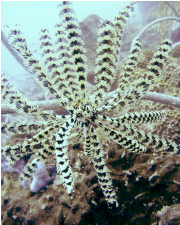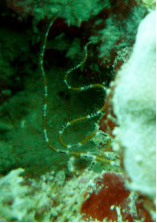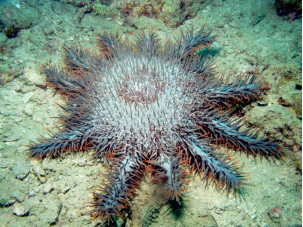Researchers' Diaries
Alison Sampey
Research Officer, Department Aquatic Zoology, Western Australian Museum
Echinoderms 2010 fieldtrip
This year’s trip to Cassini Island and Long Reef was again a fantastic experience. Spectacular scenery, sun and moon rises and sets, encounters with whales, dolphins, turtles and sharks and lots of diving! Going on trips like this is one of the best aspects of my job.
Echinoderm diversity was much higher this year (at least 57 species) than last year (at least 39 species) and I recorded more species in all of the major echinoderm groups. I collected sea stars (6+ species), sea urchins (~8 species), sea cucumbers (12 + species), brittle stars (15 ++ species), and feathers stars (16 + species). My impressions are that there were proportionally more feather stars this year than last year but a lot fewer brittle stars.
Echinoderms are difficult to reliably identify in the field requiring examination under a microscope and the use of specialised taxonomic (identification) keys and descriptions. Much of the documented diversity came from the small and cryptic fauna found in the nooks and crannies of rocks and corals. Hence, my field estimate of the number of species represents the minimum expected diversity. Last year I estimated I had at least 39 species but after the identifications were completed I found I had documented 58 species! Still, it’s great when your estimates go up instead of down!
Some species of brittle star were very difficult to collect as their body is hidden in the reef matrix and all you see are the arms, which they retract or drop off when you try to catch them. This is very frustrating, but also extremely satisfying when you finally manage to get one intact!
Feather stars were also tricky to collect as their arms tended to stick like Velcro to your wetsuit and hands. They are beautiful and delicate creatures and readily break off their arms when disturbed, but the arms and associated spines are important in identifying the animal. To collect an intact specimen requires patience, using a dive knife under their central disc and then carefully lifting it free into a plastic bag. Some species live under rock ledges during the day and others prefer to attach themselves to sea whips, sea fans and sponges.
At some sites a single species or group of species was very abundant. For example, at one shallow reef flat station, on a single 25 m transect, I counted 148 sea cucumbers (72 Holothuria leucospilota, 64 Stichopus chloronotus and 12 Holothuria atra), while at another station I recorded 77 diadem sea urchins (Diadema setosum)…watch those spines! Also recorded on a single sponge during one dive were hundreds of sticky sea cucumbers, tentatively called Synaptula cf. reticulata.
Crown-of-thorns starfish (Acanthaster plancii) were also visible on many of the dives. They were a decent size, at least 50 cm in diameter, but corals in the area appeared healthy indicating the population was naturally occurring and not causing undue damage to the corals.
I’m now looking forward to identifying the collected animals as I am sure there will be some exciting discoveries ahead.

- Unidentified feather star on a sea whip
- Photo by Alison Sampey
- Copyright Western Australian Museum

- Unidentified brittle star
- Photo by Alison Sampey
- Copyright Western Australian Museum

- Crown of Thorns Sea Star (Acanthaster plancii
- Photo by Clay Bryce
- Copyright Western Australian Museum








